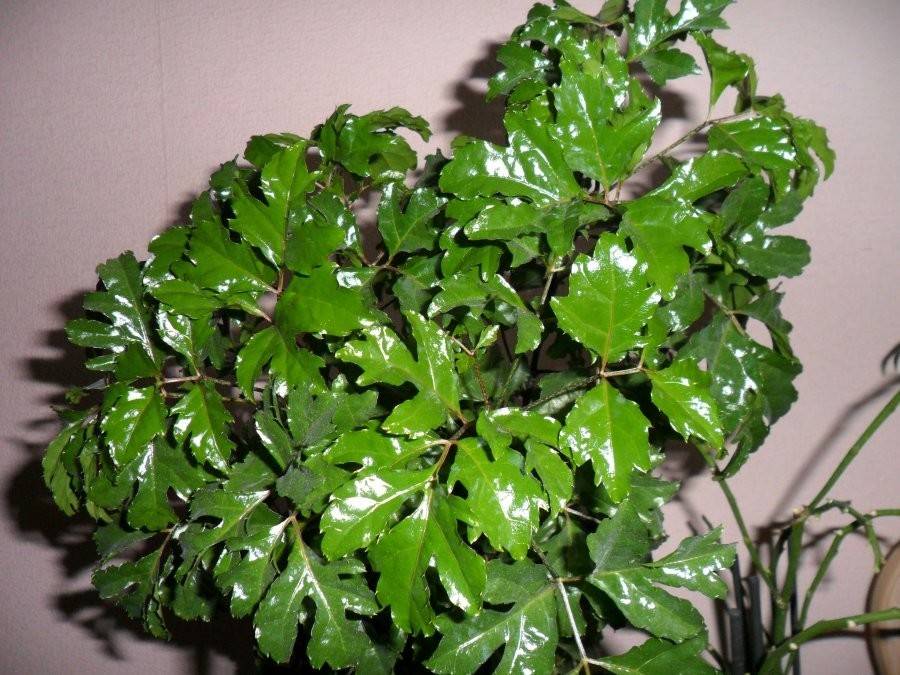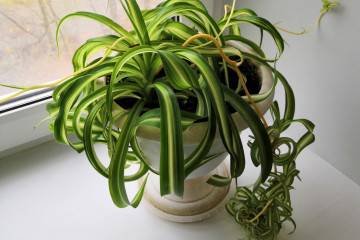Poliscias fabian - home care
Content:
People can grow cultivars at home. Their bright and rich shades give positive emotions. In particular, plants that visually resemble trees look beautiful. These include the policeman.
What does it look like, which family it belongs to
Poliscias is considered to be an evergreen plant belonging to the Araliaceae family. This plant has a branched root system. Flexible stems are covered with light brown bark. The stems are not brittle, lignified. They can be tied in a knot and then straightened with ease.
Leaves are attached with short stalks to the branches. They are bright green in color and vary in shape. There are types of this plant with rounded, lobed, narrow or pinnately dissected leaves. The leaf plate can be leathery or glossy. In addition, variegated varieties come across. The whitish flowers of the plant are collected in capitate inflorescences or in inflorescences in the form of umbrellas at the ends of young shoots. In nature, Poliscias is found in the humid Asian tropics, on the islands of the Pacific Ocean and in Madagascar.
Main varieties
The flower has 100 varieties, among which there are medium and tall shrubs, as well as medium-sized evergreen trees. More common plant varieties will appear below.
Polisias Balfour
It is a highly branching shrub with a maximum height of 1.5 m. The bark of young shoots is light green in color. The shape of the petiole leaves can be round or lobed. Their color is bright. The diameter of the leaves can reach 7 cm. The leaf plates have whitish spots and a border. When growing it at home, difficulties arise because it requires an increased temperature and humidity.
Polisias Fabian
This is a species with a thickened tree trunk. The rounded leaves are dark green with a purple tint. Fabian has thin and bendable branches. Plant height reaches 150 cm. Poliscias Fabian also requires home care.
Polisias Shrub or Frutictosa
This evergreen plant looks like a fern. Its height in the wild can reach up to 2 m. The length of the leaf plates reaches up to 20 cm. The leaves are carved with jagged edges. He forms a dense and openwork crown. Flowers are collected in panicles. Poliscias Fruicosa is unpretentious in care, copes with a long drought. People use it as a healing agent and as a condiment.
Polisias Helmet
This shrub is distinguished by a thickened trunk with a bend. Young branches stand upright. Often taken to create polisias bonsai. First, this plant develops whole leaves of a rounded shape. Subsequently, they turn into three-bladed.
Polisias Curly
Possesses shoots completely covered with leaves. They are rounded, cut twice or three times. The foliage is green with yellow spots and a white border.
Polisias Guilfoil
It is a large, branched shrub with odd-pinnate leaves that are elongated and have serrated edges. Their shape is oval. The color of the leaves is light green. They are framed with a white or yellow border.
Polisias Dull-leaved
It is a branched bush 1.5 m high with large, dark green or gray leaves. They are located on long petioles. Each leaf has rounded edges and a three-blade division. The leaves are similar to those of a tree like oak. The plant quickly adapts to its new location. Gradually, additional shoots develop in the pot.
Polisias Balfouriana
It is a small tree with a thin trunk and lignified shoots. The flower has a light brown bark. Round green leaves are present.
Polisias Fern-leaved
This is a 50 cm long bush with spreading branches and openwork green leaves. They have pinnately dissected lobes. Woody shoots have brown bark.
Polisias Hollyleaf
Has feathery leaves opposite each other. Each plate is cut into pointed segments up to the base. The leaves are painted in a light green tone.
Features of home care
The main thing that the policeman requires is home care:
- Lighting. It should be bright enough, but diffuse with little shading. Variegated varieties consume more light, but direct sunlight should not be allowed on them. The best placement is east or west facing windows. In winter, due to the reduction in daylight hours, the lack of lighting must be compensated for by phytolamps or fluorescent lamps.
- Temperature. Politsias belongs to heat-loving plants, does not require cool wintering. In summer, the air temperature should be 22-25 ° С, and in winter it is allowed to lower it to a minimum of 17 ° С.
- Watering. In spring and summer, watering should be balanced. It must be carried out as the soil surface dries up. In the autumn, watering is reduced to moderate. In winter, it is recommended to wait 2-3 days after the topsoil has dried and then water the plant. For irrigation, settled or filtered water at room temperature is used.
- Top dressing. In spring and summer, the shrub is fed with complex mineral fertilizers for decorative deciduous plants. They are used every 15 days. They are not necessary in autumn and winter.
- Humidity. The plant must be sprayed frequently with purified water. It is also additionally allowed to install an aquarium or a container filled with water next to the plant.
- Priming. Loose, drained soil with a slightly acidic PH level is considered suitable for all polisiasis varieties. The composition of the soil should include sand, peat, humus and turf mixed with clay.
When and how it blooms
This culture practically does not bloom at home, if only in rare cases. By pruning, standard trees and bonsai are formed. In the wild, inconspicuous, light paniculate inflorescences appear. The flowering period is mid-summer.
The rest period of the policeman is the end of autumn. During this period, the shrub must be minimally looked after. Spraying should be done 2 times a week. Abundant watering and feeding are not required. The most important thing is to prevent a drop in temperature and drafts in the room.
Pruning
By shaping and trimming, the flower is given a decorative look. Excessively stretched bare plants must be pruned.Lateral shoots will awaken from cutting off the top. Pruning is done during the spring season. Extra or damaged branches are necessarily removed.
How does it multiply
The bush can be propagated by seeds, cuttings, pieces of rhizomes. The seed propagation method is difficult to implement, or rather, even impossible at home. A greenhouse with special conditions is required.
An adult shrub is best propagated by cutting its upper parts in spring. The shoot should be at least 15 cm. Instructions for further actions:
- Treat the cut cuttings with a phytostimulant or activated carbon. After dry it.
- Place the scion in the ground and cover it with glass or foil.
- Place it in a room with a temperature of 25 ° C.
- Carry out periodic ventilation and moisten the soil. If all the conditions are met, you can wait for the first roots to appear 30 days after planting.
Transfer
The bush is transplanted once every 2-3 years in the spring by transshipment of the plant. You will need a large pot with holes and good drainage at the bottom. Young seedlings should not be transplanted into a large container. This can cause the soil to acidify and the plant to die.
Possible growing problems
Pests settle on leaf plates and stems. The main ones include:
- mealybug, leaving traces in the form of lumps, resembling cotton wool;
- aphid, which is a small green insect;
- scales of a brownish shade, hiding under the shell.
To get rid of these pests, you must first wash them off. After that, the plant is treated with soapy water. In extreme cases, an insecticide is used.
Over-watering can lead to rot. Transplanting and pruning the affected areas will solve this problem. A sharp change in growing conditions will also negatively affect the health of the bush.
Growing difficulties
During cultivation, the following problems may arise:
- shedding foliage;
- deterioration of the variegation of leaf plates;
- the appearance of a boring shade on foliage;
- the appearance of brown plaques and sticky deposits on the sheets.
You can avoid the appearance of these problems if you follow all the recommendations for caring for the policeman and his planting.
The polisias flower attracts florists with its appearance. Pruning and grooming properly will extend its lifespan at home.
Video





















